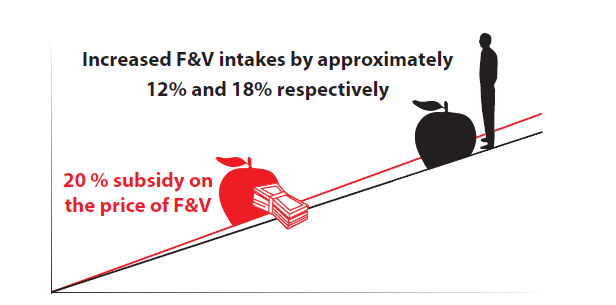Effects of Health-Related Food Taxes and Subsidies on Mortality from Diet-Related Disease in New Zealand: an Econometric-Epidemiologic Modelling Study
Food taxes and subsidies could promote healthier diets Poor diets account for a substantial proportion of disease burden worldwide, with the largest dietary risks being low fruit intake and high salt. Improving diets and reducing salt intakes were identified as priorities for international action following the United Nations High-Level Meeting on non-communicable diseases, and a number of countries are implementing action plans to achieve agreed global targets.
Health-related food taxes and subsidies, where the price of unhealthy foods is increased and/or that of healthy foods is decreased, are a potential means to promote healthier diets.
Implementation and evidence
A number of countries have introduced taxes on unhealthy foods, such as soft drinks, and evaluations suggest that they are effective in reducing consumption of targeted foods. The United Kingdom Healthy Start programme offers vouchers for fruit and vegetables to pregnant women on benefits, and Australia exempts fruit and vegetables (and other staple foods) from Goods and Services Tax. However important gaps in the existing evidence base hinder the adoption and implementation of such policies in many countries. Gaps include the effects of compensatory purchasing of nontargeted food items; impact on different socioeconomic groups; and effects on long-term health and mortality.
Study design
We aimed to estimate the effects of a range of health-related food taxes and subsidies on deaths from diet-related diseases in New Zealand. We specifically aimed to include any effects of compensatory food purchasing and to evaluate effects by income and ethnicity.
We used a computer simulation model based on New Zealand household food expenditure data, food price elasticity information, and population rates of diet-related disease to model the effects of introducing five tax and subsidy regimens. Changes in death rates from cardiovascular disease, cancer, diabetes and other dietrelated diseases were estimated.

Estimated effects on population health in New Zealand
Our model predicted that a 20% subsidy on the price of fruit and vegetables would increase total population fruit and vegetable intakes by approximately 12% and 18% respectively, and prevent or postpone about 560 deaths each year (2% annual all-cause mortality). 20% taxes on major dietary sources of saturated fat and sodium would prevent or postpone approximately 1,500 and 2,000 deaths respectively. Estimates were that combining taxes on foods high in saturated fat and sodium with a fruit and vegetable subsidy would prevent or postpone about 2,400 deaths (8% annual all-cause mortality). All effects were similar or greater for Maori and low-income households in relative terms.
Compensatory purchasing of non-taxed items
With any food pricing policy there is a risk of unintended consequences such as shifts from taxed foods to others that are equally or even more unhealthy. Our models suggest, for example, that a sodium tax could increase saturated fat purchases (by 2%) and decrease vegetable purchases (by 3%). Such effects could offset positive effects of health-related taxes but in this case the overall effects on population mortality rates remained positive. Nevertheless, it is a reminder that consideration of the full implications of any tax or subsidy package on total population diets is critical.
Some populations could derive greater health benefits from such policies
Our models also suggested that the population groups likely to benefit most from food pricing policies are Mãori and low-income New Zealanders because they experience a greater burden of dietrelated disease reflecting their higher average BMI and higher risk of cardiovascular diseases and diabetes, and are more responsive to changes in food prices.
A cost-saving and a cost-effective strategy
Relative to other strategies to prevent obesity and diet-related disease, health-related food taxes and subsidies are likely to be highly cost-effective. Previous studies found that taxes on unhealthy foods and beverages would be cost-saving and considerably more cost-effective than individually-focussed weight reduction programmes or community or school-based education programmes. Whilst subsidising healthy foods like fruit and vegetables is costly, packages of taxes and subsidies may be the best option for both population health and national economies.
Conclusions
Overall, our research suggests that health-related food taxes and subsidies could improve diets and reduce mortality from dietrelated disease in New Zealand. However, there are uncertainties in such modelling, e.g. potential healthier product reformulation by industry in response to taxes and subsidies, which could enhance health gains. Our study adds to the growing evidence base that food taxes and subsidies should improve population health and reduce inequalities, but there is still much room for improvement in the estimation of health impacts.
